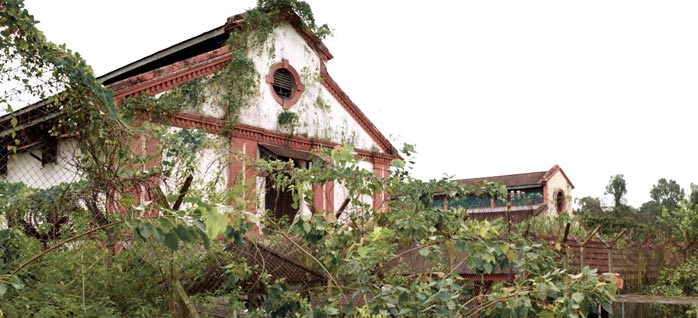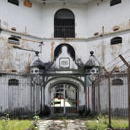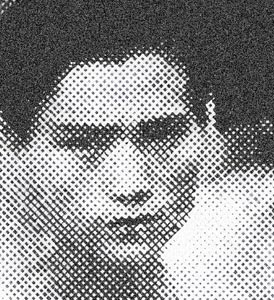| |
| |
 |
JOHOR
BAHRU PRISON
March
17, 2025
Over
a 5 year period I photographed and researched this
former Victorian era state prison. In its long storied
history it became a political
pawn used by the British and later a place for war
crimes during the Japanese occupation in WW2.
Tags: #kotajail #penjaraAyermolek
#johorbahru #lokap
|
|
|
|
| |
|
|
|
|
|
Located
along Jalan Ayer Molek, is Johor Bahru’s (JB)
first original prison, it’s also the 2nd oldest
building in JB after the Istana Besar. With stories
of murder and executions, the prison has naturally
held a macabre fascination with the public, made even
more so when the site was left abandoned, becoming
a popular haunt for ghost hunters and thrill seekers.
The jail was built in 1884 under the orders of Sultan
Abu Bakar, the Sultan of Johor. The construction work
was awarded to the then prominent Chinese contractor
of the day, Wong Ah Fook. Construction took two years
to complete at an agreed price set at $ 30,000.
The
prison’s opening ceremony was a grand affair
attended by the Sultan and honoured guests. The road
outside was decorated with venetian poles, flags and
the guard house was decked out with festoons and bunting.
A silver key was specially made for the ceremony and
it came with its own ornamental box with a violet
lining.
Behind
its high walls, the prison was composed of many different
buildings, such as a canteen, workshops, a hospital,
dispensary and cell blocks. In its overall construction
no stone was left unturned; at the planning stages
the foundation work had even been specified to be
made from granite sourced from quarries on Pulau Ubin.
|
|
|
|
|
| |
|
|
|
| |
|
As materially solid as the prison had been built,
it still bore a hidden weakness. Little did Sultan
Abu Bakar know, but his newest creation was one day
going to be the very undoing of Johore’s ruling
elite. Abu Bakar however was never going to witness
these events for himself, passing away in England
in 1895 where upon his son, Sultan Ibrahim inherited
his throne.
Johore
at that point in history had been one of the last
hold-out independent Malayan states outside the British
controlled Federated States of Malaya (FMS). The FMS
was first established 1895 and was composed of 4 states,
Selangor, Perak, Negeri Sembilan and Pahang.
Britain had been looking for ways to bring Johor into
the FMS fold and thus have complete control of Malaya
as a whole.
The
prison became a focal point of contention, but it
was just the cherry on top of a much larger mountain
of issues that the British had with Johor’s
running.
In
1911, there was a breakout from the prison’s
hospital . A meeting was arranged with the Sultan
to discuss the incident as well as to bring up other
points about the prisons administration.
Below were some of those concerns :
News prisoners into the facility
were not given any medical screenings, a risky decision
for any densely populated institution. Prisoner’s
criminal backgrounds, whether it was petty offences
or serious crimes, were not taken into account and
everyone was treated the same, including locking them
up in the same cells. The British also had misgivings
of shackled prison labour being used on private estates
of the elites.
From
this point on there was a powerplay for control between
the Sultan and the British, this was not only for
control over Johor prison but for the entire state
of Johor itself.
The
Sultan was certainly unhappy at any attempt to take
power away from him and over the next couple of years
undertook certain steps to redress the balance of
influence where he could, much to British frustrations.
In
1914, things started to come to a head when a Prison
Commission report was ordered by the British on Johor
prison. The thorough report went on to showcase how
ill managed and how dire the conditions had become
there. The report was to be one of the main tools
to finally wrestle power away from Sultan Ibrahim
and into British hands.
The
British drew up a new treaty which Sultan Ibrahim
was compelled to sign. The treaty gave the British
General Advisor to Johore far reaching powers which
essentially side lined the Sultan. The Sultan had
to now accept all advice given by the General Advisor
on all things, except for matters of Malay religion
and custom.
The
era of British Malaya had now begun.
|
|
|
|
|
| |
|
|
| Related |
 |
| Pudu Gaol |
 |
 |
| Copshop |
 |
|
| |
|
|
|
| |
|
|
|
| |
During the inter-war years, the prison expanded in
scale with the addition of new buildings to support
the needs of a growing prisoner population. This also
included female prisoners who were housed within their
own area.
Inmates were actively put to work outside the prison’s
walls labouring for the Public Works department and
undertaking jobs such as earth works, drainage and
tree felling. Inmates who remained inside were also
employed in work which included baking, carpentry,
tailoring and furniture making.
Under
the Vagrancy act of 1921, Johor prison was also used
as a Vagrant Ward, housing vagrants with the view
to keep them off the streets and for finding them
work. However, those able-bodied who refused to work
could face imprisonment or if applicable, be deported.
From
its inception, the prison was also actively tasked
in carrying out the death penalty.
It’s been claimed that in the early days of
JB’s history, executions were held in public,
with frenzied crowds thronging to see such disturbing
spectacles.
Before
British administration in 1914, the gallows were reported
to be located behind the prison, outside of its main
walls and in public view. The gallows was even said
to be within view of at least one neighbouring residential
bungalow, where it had allegedly been customary to
view such hangings, whether intended, or not!
|
|
|
|
|
| |
A
1909 newspaper report paints a vivid scene of one such
execution as witnessed by a reporter.
|

"The execution was carried out with every despatch,
but it was a terrible sight to witness four persons
being hanged at one time and struggling in vain during
the few minutes before life was extinct."
(Executions at Johore. Four murderers hanged yesterday
morning. Straits Times, 1909, March 5th)

|
|
|
|
| |
“Struggling in vain”, is a disturbing
but interesting observation, it suggests that the
prison at that time was still conducting hangings
using the outdated short-rope technique.
In England in 1872, a newer hanging method called
the long-drop had been scientifically developed, whereby
a prisoner’s weight and height is factored into
the method. The new process was all about swiftly
dispatching the condemned by cleanly breaking their
necks. The old short-rope method merely worked by
strangulation which could take several agonising minutes
until death occurred.
At
least in the British controlled Federated Malay States,
the long-drop method was already being discussed,
and a document dated from 1882 outlined this technique
with explicit written details of the whole dreadful
procedure. Johor’s adoption of this technique
was seemingly yet to take hold at least until perhaps
British administration took over in 1914.
In 1916, a fascinating written account by visiting
Australian sailors described how things had since
changed at the prison. Executions had now been moved
within the prison walls and the gallows was described
to have looked more like a store or stable than a
place of execution. Entry into the gallows was up
4 wooden steps and through a pair of old wooden doors.
The interior was simple and functional; a pair of
trap doors, a lever and a hempen rope was all that
was pointed out.
|
|
|
|
|
| |
|
|
|
| |
When World War 2 came, the fall of Malaya to the invading
Japanese was swift and bewildering to its colonial
defenders. These events also produced an ironic twist
of history where many of Malaya’s former white
masters ended up interned inside their own former
prisons. But for all those held captive, civilians,
soldiers, Asians and Europeans alike, conditions were
harsh and brutal for everyone.
Command
at all the prisons in Malaya including Johore, fell
under the control of the infamous Japanese military
police, the Kempeitai. Arguably, it was during these
times that the prison’s notoriety really took
root within the public imagination with stories abound
of torture and executions. Stories have even been
passed down through the decades by serving Malaysian
prison guards, even to this day.
After
the war, a war crimes investigation team was put together
in 1946 to collect information and find witnesses
of alleged abuses that had occurred at the prison.
The team was under the command of Flt Lt P.A Townsend
(Administrative And Special Duties Branch), and was
headquartered at the Supreme Court building in JB
town.
By January 1947, 13 Japanese war criminal suspects
and 20 convicted Japanese war criminals were being
held at the prison. More sobering were the figures
across the causeway at Changi jail, with 1315 Japanese
war criminal suspects held, 37 awaited the death penalty
and 70 having already met their fates at the noose.
There exists two war crimes cases of particular interest
as these offences had occurred inside Johor prison
itself. |
|
|
|
|
| |

CASE 1
|
|
The first case involved a Seargent
Teruo Yamaguchi. Yamaguchi was convicted on 3 charges,
2 of the charges were for the killings of two prisoners
and the 3rd charge alleging the killings of ‘numerous’
others as of unidentified prisoners in the prison’s
interrogation room.
Yamaguchi was witnessed to have used various forms
of torture on prisoners which included, beatings with
a 4 foot, 4 inch thick rod, electrocution, water torture
and beatings using “Jujitsu style” attacks.
There was clapping in the courtroom when Yamaguchi
was handed the death sentence in August 1946. Yamaguchi
was to be the very first war criminal to be put to
death at the prison. An official release stated that
it was reasons of ‘poetic justice’
that the execution be carried out at Johor and not
Changi.
|
|
|
|
|
| |
 CASE 2
CASE 2 |
The
2nd war crime case was against a Seargent Takoa Homma.
Homma was nicknamed “prince charming”,
by prisoners. Homma had been conducting an interrogation
and torture on 2 prisoners on 3 separate days over
the month of April 1945.
On the last day, Homma had hung by the neck one of
the prisoners with a rope tied from a ceiling beam.
Whilst hanging, the prisoner was swung back and forth
by the accused and his Taiwanese assistant for 15
minutes, then left dangling for another 5 minutes,
after which the prisoner’s lifeless body was
cut down.
Homma
was also accused in another incident where he tortured
a prisoner at the prisons water well. The prisoner
was first beaten with a cane then had his hands tied
and was held under water for 5 minutes in the well.
It’s interesting to note that the water well
site is a common focal point in old horror stories
passed down that regularly link it to prisoner abuses.
The well today is commonly known as “General
Yamashita’s well’, named after the Japanese
commander of the invasion force of Malaya in WW2.
Homma was put to death on July 21, 1947 at 9am, at
Johor prison.
|
|
|
|
|
| |
|
|
|
| |
Just as Malaya was sorting its self out after a world
war and laying those demons to rest, that a new bloody
conflict appeared on its doorstep. In 1948, communist
insurgents began a guerilla war against the colonial
government with the aim of independence from Britain
and forming a Malayan communist state. This period
is known as the Malayan Emergency.
The
British declared a state of emergency and implemented
the Emergency Regulations. These harsh regulations
granted far reaching powers to the authorities over
such things as arrest, detention and movement. Under
these conditions, the courts could apply the mandatory
death penalty to anyone caught with an unauthorised
firearm, ammunition or explosives.
Newspapers
of the day regularly reported on the court trials
and executions of communist terrorists, including
those convicted and put to death at JB prison.
|
 |
|
One
such news story was about Tan Ah-Seng who had been a
former village school master and was also described
in court as being, “the best-known Communist
leader in Johore”.
Tan was caught with a revolver and ammunition and was
sentenced to death in September 1948. As Tan was led
to his execution, he sung the communist hymn, the Internationale. |
By 1960, the communist emergency threat had come to
an end. During the span of the emergency, 226 people
in total received the death penalty for terrorist offences,
with 62 hanged in just the first 11 months of the troubles.
Out of these figures, Johor prison’s specific
number of executions is unknown to me, but, from my
own findings I did total up 36 individual names through
archived newspaper articles dated from between 1948
and 1952. After 1952, these types of newspaper reports
seemed to have stopped completely.
|
|
|
|
|
| |
In
1963, Malaysia had to once again face down yet another
armed conflict. This time it was an undeclared war
initiated by Indonesian president Sukarno’s
opposition of the creation of the state of Malaysia.
This conflict became known as the, Indonesian-Malaysian
Confrontation.
There were many cross-border battles in East Malaysia
as well as small enemy unit infiltrations into West
Malaysia, including Singapore.
Captured
Indonesian soldiers were held at various detention
centres dotted around Malaysia, which included Johor
prison. In 1966, the conflict ended when Sukarno was
deposed. Later that same year, all 445 prisoners of
war held at Johor were repatriated back to Indonesia.
|
|
|
|
|
| |
|
|
|
| |
Up through the 2000’s, JB prison remained in
operation but it languished in a time warp. The prison
was now over 120 years old, it was out of date and
un fit for purpose in modern times.
From
2005 onward, the prison saw a patchy period in its
existence, it closed down, became a museum, then later
reopened again as a police remand centre.
As a remand centre, in function it ticked over but
was still burdened by all the same problems it previously
had, over-crowding, crumbling infrastructure and outbreaks
of disease.
Finally in 2018, the old prison was shutdown for good
and the site left completely abandoned.
The
prison was left to dwell like this for several years
where it quickly became overgrown and wild. In that
time a kind of peacefulness was created within it;
the urban hustle and bustle was kept at bay by the
high walls and in a way the prison became like a secret
walled garden. This inner sanctuary attracted an abundant
array of wild birds who nested within its green spaces
and filled the air with their song.
However, a different atmosphere entirely awaited anyone
who dared enter the prison’s old cell blocks.
Out of the sunlight, these old interiors rotted away
in a dark twilight world. The air inside was thick
and laced with the ever-present odour of decay. One
could easily imagine unspeakable demons conjured from
the prisons bloody past dwelling there, watching and
waiting.
In
2025, the prisons fortunes have since changed for
the better. With the help of a private group and local
government, work has begun to restore and persevere
the 142 year old prison. The ultimate plan is to see
the prison repurposed into a museum, market, as well
as a centre for cultural and arts events.
This
is a great initiative and one that I hope will help
secure the prisons existence for decades to come.
Whatever
the prisons future, the site is an important corner
stone of Johor’s history. Its preservation and
survival is of great importance for current and future
generations to learn and appreciate its legacy and
the part it played in forming what is Johor and Malaysia
as we know it today. |
|
Copyright 2025 ©
Raz Talhar
|
|
|
|
|
|
|